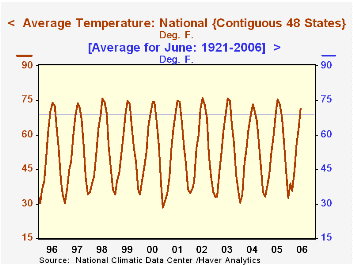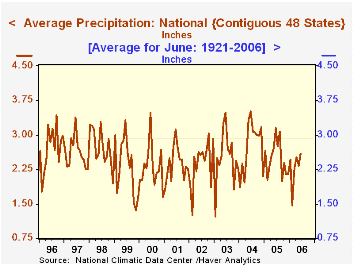 Global| Jul 05 2006
Global| Jul 05 2006High & Dry: June Temperature Near Record and Rainfall Well Below Average
Summary
The national average temperature in June was 71.4°F, up 1.8° from last June and 2.25° higher than the average of the last 86 years. In that 86- year span, only 1933 saw a higher June figure, 72.0°, although several years have been [...]

The national average temperature in June was 71.4°F, up 1.8° from last June and 2.25° higher than the average of the last 86 years. In that 86- year span, only 1933 saw a higher June figure, 72.0°, although several years have been above 71.0°.
Rainfall was a little short this June, and although not nearly a record low, was much less than the last several years. The national average amount was 2.58", compared with 3.15" in June 2005 and 3.52" in June 2004. These were relatively wet times, though, as seen in the table below, with an average since 1921 of 2.92".
These data come from the National Climatic Data Center, a branch of the Commerce Department in the division known as the National Oceanic and Atmospheric Administration. The National Weather Service is another part of the same Administration. Haver maintains temperature and precipitation by region and state in our REGIONAL database and the national averages are in USECON.
In assessing these data, we made use of some tools in Excel along with the DLX add-in for Excel. Copying codes into a spreadsheet is really easy with the latest versions of DLXVG3. Putting it in "Excel mode" leaves the menus visible. In Excel, we place the cursor in the cell where the first code will appear. In DLXVG3, we highlight the menu item we want, or to get a whole list, we can just click to the left of the first menu item we want and paint down the list as far as needed. Magically (seemingly), the codes and the database name will appear in the spreadsheet.
Instead of the typical date-span entry, we begin to enter the dates manually: for June of each year, we would type in 192106 and 192206. Then, we highlight those cells, grab the box on the corner and drag it down as far as needed. Excel will see the pattern in the dates and replicate it all the way down the column. In setting the range, we'll need to highlight the entire area covering the columns of codenames and the rows of dates. Then when we retrieve the data we'll have June of each year for 86 years for whichever items are of interest to us.
For instance, I retrieved temperatures for the nine special weather regions and used Excel functions to find the maximum, minimum, median and mean. A quick look at these figures and the bottom row of data shows that only one region, the West, set a new temperature record in June, but seven of the nine regions had above-average temperatures for the month. The maximums for each show that most records occurred many years ago: three in the early 1950s, one in 1943 and one in 1933, the same year as the national record. Besides the West, recent records were in the Southwest in 2002 and in the West North Central states in 1988.
| June Weather | June 2006 | June 2005 | June 2004 | Averages for Junes||||
|---|---|---|---|---|---|---|---|
| 2001-2006 | 1976-2000 | 1951-1975 | 1921-2006 | ||||
| Temperature (degrees F) | 71.4 | 69.6 | 68.5 | 69.78 | 69.24 | 68.26 | 69.15 |
| Precipitation (inches) | 2.58 | 3.15 | 3.52 | 3.07 | 2.93 | 2.85 | 2.92 |
Carol Stone, CBE
AuthorMore in Author Profile »Carol Stone, CBE came to Haver Analytics in 2003 following more than 35 years as a financial market economist at major Wall Street financial institutions, most especially Merrill Lynch and Nomura Securities. She had broad experience in analysis and forecasting of flow-of-funds accounts, the federal budget and Federal Reserve operations. At Nomura Securities, among other duties, she developed various indicator forecasting tools and edited a daily global publication produced in London and New York for readers in Tokyo. At Haver Analytics, Carol was a member of the Research Department, aiding database managers with research and documentation efforts, as well as posting commentary on select economic reports. In addition, she conducted Ways-of-the-World, a blog on economic issues for an Episcopal-Church-affiliated website, The Geranium Farm. During her career, Carol served as an officer of the Money Marketeers and the Downtown Economists Club. She had a PhD from NYU's Stern School of Business. She lived in Brooklyn, New York, and had a weekend home on Long Island.





